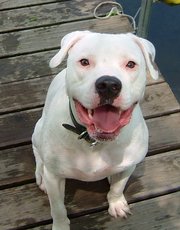|
Dog breeds of the world, American Bulldog |
| American BullDog | ||
|---|---|---|
| Alternative names | ||
| Old Country BullDog | ||
| Country of origin | ||
| United States | ||
| Common nicknames | ||
| Classification and breed standards | ||
| UKC: | Guardian Dogs | |
| Not recognized by any major kennel club | ||
| This breed of Dog is extinct | ||
| Notes | ||
The American BullDog is a breed of working Dog developed for catching livestock and for protecting property.
The American BullDog is a stocky, strong-looking Dog. Its coat is short and either white or white with patches. There are generally considered to be two types of American BullDog, the Johnson type and the Scott type. These are named after the breeders who were influential in developing them, John D. Johnson and Allen Scott. The Johnson type is a larger Dog with a shorter muzzle than the Scott type. However, many modern American BullDogs are a combination of the two types. Generally speaking, American BullDogs weigh between 27 to 54 kg (60 to 100 lb) and are 52 to 70 cm (20 to 28 inches) at the withers.
There are two distinct strains of American BullDogs, Classic (Johnson, Bully) and Standard (Scott, Performance) which is often mistaken for its second cousin the American Pit Bull Terrier because of its appearance, and for its much smaller European relatives because of its name, the American BullDog is different from any of these. The American BullDog is massive in comparison to the French BullDog or English BullDog and were never bred to be lap Dogs (and they can't even fit onto one.) The Standard American BullDog does resemble the pit bull type breeds on many points, such as being muscular Dogs that can be all white or white with patches. However, the pit bull's head is in the shape of a wedge coming to a more rounded point at the muzzle, whereas an American BullDog's is box-shaped. The American BullDog's ears are also typically uncropped, it is heavier and a little bulkier.
 American bullDogs can make great family Dogs despite their reputation.
American bullDogs can make great family Dogs despite their reputation.
An American BullDog is typically a happy, friendly and assertive Dog that is at ease with its family and fine with strangers as they get to know the stranger in question. They are quite fond of children but sometimes do not know their own strength, thus they should be supervised with small children. They bond strongly with their master and family but, because of strong guarding instincts and a somewhat dominant attitude, they need a firm but fair hand; they should be socialized and obedience trained early to expose them to other Dogs and people and to ensure they can be controlled around company as they get older (and much larger.) They need room to expend their energy and so do best in a home with a backyard; they can be stubborn with training though once they are trained they tend to obey their masters faithfully. They are not always well behaved towards cats and smaller pets, but correct socialisation at an early age can greatly increase the chances of them accepting these animals.
In England during the 17th and 18th centuries, the now extinct Old English BullDog's were used on farms to catch and hold escaped livestock and also as butcher's Dogs; it was believed then that sending a Dog out after a bull would tenderize the meat. This eventually led to the bloodsport of bull-baiting, popular with the poor and rural areas for both entertainment as a bloodsport and the potential for gambling. These practices extended not only to the British Isles but also to the colonies she accquired during this time, including what is now the United States and in particular the South; many of the settlers brought their Dogs with them to help around the farm, hunt in the woods, and to gamble.
In 1835, the sport of bull-baiting was outlawed in the United Kingdom and over time the English BullDog became the more compact and complacent version known today, but the much more athletic American strain continued on much the same in the rural South even as its popularity declined in favor of other breeds. By World War Two the breed was near extinction until John Johnson and Allen Scott scoured the backroads of the South looking for the best specimens to revive the breed.
Due to a fallout between Johnson and Scott,both of them later went their separate ways and developed 2 slightly different versions of the American bullDog. Today the American BullDog is safe from extinction and is enjoying a healthy increase in popularity both as a working Dog and as a loving family pet. In the South and West they are used as "hog Dogs" (Dogs used in the catching of escaped pigs and/or hunting razorbacks) and are also used in tracking, driving cattle, and weight pulling.
American bullDog puppies can be relatively difficult to housebreak. Their stubborn nature makes discipline seem useless, but it is important to be persistent. Make sure to completely deodorize old 'mistake' spots or the puppy will want to eliminate in the same area again.
During the 1990s Walt Disney Productions released the Homeward Bound series which featured an American BullDog named Chance.
In 2004, the same company released a film called Cheaper by the Dozen, where the family pet is an American BullDog.